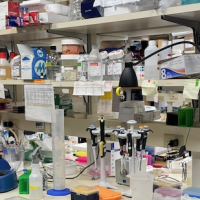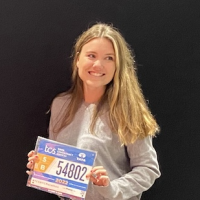Endofound’s Sixth Annual Medical Conference: Ending Endometriosis Starts at the Beginning
Have robotics replaced traditional laparoscopy in the surgical treatment of endometriosis?
Michael Nimaroff, MD
Thank you very much and thanks to Endofound, Dr. Seckin and Dr. Reich, Dr. Liu for inviting me to participate. I only have one disclosure; I am fully employed by North Shore-LIJ Health System. That is my disclosure. I hope you have rested up. I know I have after hearing the last session because am going to try to tie it all and bring it all together. It is interesting. Without having seen my lecture how my talk will hopefully give you an answer and we are going to skip over a lot of this to save time because I am sure you have heard all this about obviously the nature of endometriosis. What I am going to concentrate on today is really more with robotics is not on the early stage disease and diagnostic endometriosis surgery that we have heard earlier but really more on advanced stage endometriosis.
Surgical excision for advanced endometriosis requires obviously proper pre-op evaluation, detailed consultation and obviously planning about the surgery as well as clearly fertility plans for the patient and her husband. This commonly involves obviously small bowel, large bowel, bladder, ureter, basically everything in the pelvis or abdomen. It requires the surgeon to have a thorough understanding, and I think this is key really to this robotic laparoscopic argument, it is the experience. It is the thorough understanding of the tissue planes, ability to use both hands when we are talking about laparoscopy. And I will get into that a little bit more in a few minutes. With laparoscopic excision the key, and what is more difficult, is that issue is that the surgeon needs two fully functional hands with that hand eye coordination and sewing should basically be as easy endoscopically/laparoscopically with so-called straight sticks as it is with robotics. And the key again, we all need to know our limitations.
Really quick, but again, obviously growth of robotics, the robot is a great instrument. It is an absolutely phenomenal instrument. And there has been tremendous growth and benefit for women in particular and for many patients because of robotics. As you see, once in 2005 when the robot was first approved for gynecologic surgery and for hysterectomy in particular there has been a real growth in minimally invasive hysterectomy in women.
Also, other procedures and if we just touch quickly here it is the other, also other procedures so there has been growth in robotics and in minimally invasive surgery in particular. That has been a really good benefit and certainly other specialties it has had tremendous benefits. I am sure, we do not have studies on this, but clearly from the talk here and from our little discussion earlier, clearly there is also growth in endometriosis as well. And again, just really quick, why is the growth 3D optics articulating instruments virtual reality control and again, I believe there really is a shortening and there is some evidence on this. Shortening the learning curve for managing complex tests mainly suturing and some of the other complex dissections that is why it took off in prostates again as Dr. Seckin mentioned about that anastomosis of the urethra. There is high surgeon confidence, there really is, there is high surgeon confidence from many surgeons and comfort, especially for the slightly less experienced surgeon. If we are all honest, I do not want you to raise your hands, but if you are honest how many people really have complete hand/eye coordination with both hands. I was going to give out clickers and what have you. Obviously we are in a room with many, many experienced surgeons, experienced laparoscopists who do not have an issue with this and this is why many of them do not feel any real benefit for the robot. I think that is really one of the key things.
Now I am pretty good with both my hands. I have a video of that in a minute. I am just going to let this play a little bit, this little video but just about articulating instruments I am going to fast forward because I want to show you a couple of things. This is the main one. We have articulating instruments with so-called straight sticks also. I have been using flexible tips, scopes on every single one of my cases for the last decade and I tell you all, do it! If you have access to it I am sure it will help if you are using angle scopes at least.
We have really good instruments today, even for our straight conventional laparoscopy. I have 3D flexible tip scopes. I do not know if any of you have it in your hospitals but we have a flexible tip 3D 10 mm endoscope. It is beautiful and it has narrow band imaging and I honestly do not have the answer what is NBI versus its Firefly pick up of endometriosis. But the NBI costs nothing if you have the scope. But again, you need extensive experience and this is key for conventional laparoscopy to do this complex stuff, and that is really it. The same thing is true with robotics. You need experience and everybody talks about experience, experience with robotics, how many cases and so forth. I am just going to forward.
I am going to let this play I know you have had videos on robotic excision of bladder endometriosis. This is just a case we did recently. I actually like doing the robot on this – we could have done it without the robot but it was nice, already dissected from her endometrial, from her C-section scar. Truthfully, it is just a nice procedure so I just, I do robotics as well. I have done them since 2005. I do not do really any hysterectomies with the robot but I like it for some cases. And I like it for multiple myomectomies even though I do straight stick myomectomies as well. I use it as a tool when I think it adds for me a little bit of a benefit. And there are some times when even I think “you know it’s nice to do it that way”.
I do not want to offend anyone we are going to get into some studies here. I am going to play only a little bit of this video. If you have seen it, it is pretty funny, watch it on YouTube. (German video clip.) It goes on and on I just encourage you all to watch it, it is really funny.
Robotic treatment of colorectal disease – this was a study of human reproduction, 22 cases of deep infiltrating endometriosis. There were no complications, no conversions. In other words this can be done well, safely and is certainly is an option. What about perioperative outcomes in robotic assisted scope versus conventional scope for advanced stage? This is Dr. Farr Nezhat. Again, retrospective cohort. One experienced surgeon, 86 laparoscopic cases, 32 robotic. There were no differences in the outcomes. There was increased OR time in one of the robotics group and actually interesting it was a group with elevated BMI.
Going further, robotic assisted versus conventional by another familiar name, Camran Nezhat. Retrospective cohort, again, one surgeon over eight years, 420 patients. No difference in outcome, robotic group longer operating time and the mean difference was about an hour. Again, these were obviously experienced laparoscopists, experienced robotic surgeons.
And of course, the AAGL position statement, only one retrospective cohort comparing traditional to robotics for endometriosis so we still cannot comment. No significant differences found in that one study. We do not have any really good randomized controlled trials showing us whether one is better than the other. It seems like they are very similar. Outcomes and committee opinion from ACOG, again, significant growth but four randomized controlled trials show no benefit over traditional scope for treatment of benign disease. Obviously there are a lot of studies with endometrial cancer and certainly it is being used in large percentage in gynecology. But to me the robot is a $2 million left hand or right hand if you are a leftie. The learning curve for developing the necessary skill set for complex procedures is clearly shortened with robotics. It is. You could train someone, obviously a novice, in an hour they can sew like a pro. You take another resident, put him through four years of training and they still will not do it 16 years later when they are attending. It is much more difficult to pick up some of the skills necessary.
Visual benefits, obviously the 3D, the instruments all great and certainly for certain subgroups of patients, the elevated BMI patient, you know what, it is a very nice approach to use.
But studies with complex endometriosis cases all that we have so far are all experienced surgeons. The question is we may see if we, and I recommend if we have residents we try to do this, it should be done, is really looking at the inexperienced. The lower, I do not want to say inexperienced because we should have no inexperienced surgeons, but our surgeons who are less experienced, who do a few less cases, not doing hundreds of cases – maybe doing 50 cases a year or less, a little bit less we should see maybe there is an outcome difference. Maybe the robotic technique would be beneficial in that group. That is why it has grown so much is that our low volume doctors who really did not have laparoscopic skills feel very, very comfortable when they sit on the robot. That also has led to trouble, a lot of lawsuits because again, you need to have the skills regardless. The jury is still out on that.
But again, there are deficiencies. We have issues, increased numbers of robotic procedures replacing traditional laparoscopy. I know in our program our residents are doing more and more, our oncologists in particular, doing more and more robotics that their traditional laparoscopic skill training is really deficient now, even though there are a lot of us that still do a lot of laparoscopy. But it is a problem. And even our experienced laparoscopists we have a few of our gynecologists who actually were excellent laparoscopists years ago and they are no longer excellent laparoscopists. They need the robot. They used to know how to sew, maybe not great, but now they cannot and it is a problem. Also, we have not real formal simulation curriculum and we need this. I know ACOG has started to do this and people are working on this but this is what we need. And the increased demand in our schedules of our residents along with work limitations certainly also hurt. There is surgical training. We have very few, and I would say almost no residents graduating who have that hand/eye coordination necessary to do real complex surgery. It is a shame but we need to work on that.
Going further comparing MIS skills acquired in pgy1 residents four hours of proctor time. This is sitting on a robot simulator versus sitting on a laparoscopic simulator. Was there a difference? It was only four hours of proctor time. Both groups improved with training. The robotic group improved a lot more, which again, goes along. You sit on that and your learning curve is really pretty quick, it is pretty steep. The simulation training, does it improve operative performance? We have studies that show that. A lot of this is from the general surgical literature but they were assigned to either an FLS video trainer, the fundamentals laparoscopic surgery, versus the Lap simulator and they had an operative rating scale that has been proven. Basically both groups improved with simulator training. Actually the traditional FLS box trainer basically they improved even more than the fancy simulator.
How can we improve skills? This is really it. This is another study looking at curriculum. This is stuff that we can practice on outside and the only way anyone is going to get better doing this and really develop those skills is practice on the outside. You cannot do enough cases. We need a formal really intensive program and honestly even training fellows, my fellows who operate a lot, how long can I let them if I have a day where I am doing four cases back to back, how long can I let them with limited sewing skills actually sit there and actually close the cuff or do whatever it is? They also need, everybody needs the practice on the outside and we can do that.
Methods do improve, what can we do? This is not even, this is pretty fancy, this box string, obviously there are a million of them. You can create your own if you go on the web. You can create it out of a shoe box, whatever, Ethicon gives them for free. There are all kinds of things we can do but it does not have to be fancy. It does not have to be a $150,000 simulator. It is all just basic hand/eye coordination.
Then other steps, this was taken in Utah not too long ago. But that is what I do. I actually practice – I tell my residents to do this. It is not exact but if you develop coordination with your non-dominant hand it helps. It works not only in the OR, or eating, but it also works on the court. You can practice. You can learn to use your non-dominant hand and you have to. It is key, it was key for when I played basketball, obviously a little while ago, but you know, you need to do this. But the robot obviously gives you that automatic control that is why it has taken off because very quickly you sit down and you feel you have – it is intuitive. It is a great name, what can I tell you? It is just intuitive.
Finally, even video game playing – this is a study that just took students and they did a baseline score and then they took two hours of Wii playing versus four hours of Wii playing. There were specific games I am not going to get into which games you can look it up. Both groups improved just playing video games. Honestly, I grew up playing video games. I am old but they came out. I played Pong as soon as it came out.
Then finally just to sum things up. The studies show there are no outcome differences between the two groups for advanced stage endometriosis. Having said that though it is all super experienced laparoscopists – these are very experienced surgeons. No data on the outcomes of less experienced surgeons. We certainly need to increase our training and complex endometriosis cases regardless should be performed by experienced surgeons. Thank you very much.










